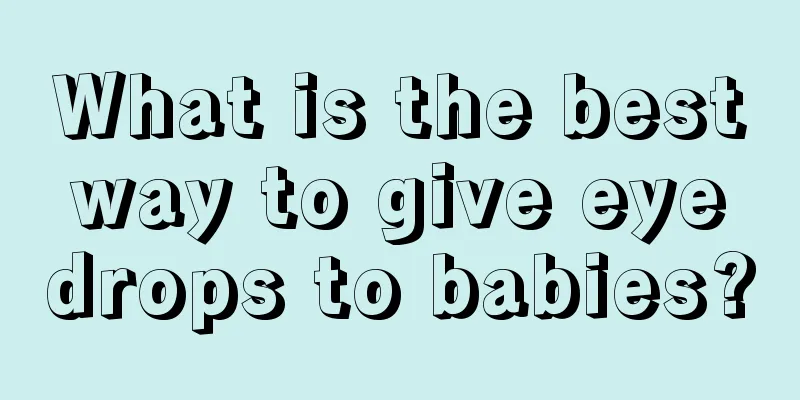What is the best way to give eye drops to babies?

|
Many mothers have worries of one kind or another when they just give birth to their babies, such as worrying that the baby will not sleep well or cry. Putting eye drops in can make the baby's eyes brighter. Many parents think that babies do not need eye drops. If there are any problems, they can seek help from a doctor to make their baby's eyes better and better, and parents can feel more at ease. So, the editor would like to explain to you how we should give eye drops to babies. Method for applying eye drops: Let the baby sleep or sit on a chair with his head tilted back appropriately and his eyes looking upward. Use one hand to gently separate the lower eyelid without pressing the eyeball, and drop the medicine into the eye. Generally, one drop is placed in each eye. After placing the drops, gently lift the upper eyelid to evenly distribute the medicine. Press lightly between the eye and nose with your hand for a few moments to prevent the eye drops from flowing into the nasal cavity through the nasolacrimal duct too quickly. When putting eye drops in, the mouth of the medicine bottle should not touch the eyes to prevent the child from crying and accidentally hitting the eyes and contaminating the eye drops. Close the bottle cap tightly after using up the eye drops. Place it vertically in a cool place and keep the mouth of the eye drops bottle clean. If the eye drops change color or have sediment, it means they have gone bad and should not be used anymore. When applying eye drops, parents should first tilt the baby's head back, use the thumb and index finger of the left hand to gently separate the baby's upper and lower eyelids, or just use the thumb to gently pull the lower eyelid downward to form a small pouch between the eyelid and the eyeball. At the same time, hold the eye drops bottle in the right hand. The mouth of the bottle should be 2 to 3 centimeters away from the eye. If it is too close, it will easily touch the eyelids and eyelashes, causing contamination of the bottle mouth and the medicine solution, and sometimes it may accidentally damage the cornea. The medicine should be dropped into the small bag instead of directly onto the cornea, because the cornea has a lot of sensory nerves and closing the eyes suddenly can easily squeeze out the medicine, affecting the treatment. After applying eye drops, gently relax the eyelids, wipe off the overflowed medicine with a sterilized cotton ball, let the baby move the eyeballs slightly, and close the eyes for 3 to 5 minutes to allow the medicine to be evenly distributed on the affected area and to fully exert its efficacy. You should close your eyes after applying the medicine into your eyes, which can extend the effective time of the local medicine by 5 times. Therefore, it is extremely important to close your eyes and rest after applying eye drops. Generally, eye drops can be applied 3 to 4 times a day, 1 to 2 drops each time. If two eye drops are used at the same time, you should close your eyes and rest for 15 minutes after applying one before applying the other to fully exert the efficacy of the medicine. Increasing the number of eye drops is more effective than increasing the concentration of the medicine. After putting eye drops in, if the skin around the eyes feels itchy or even red and swollen, it means an allergic reaction has occurred. In addition to stopping the medication immediately, you can also take anti-allergic drugs such as chlorpheniramine for treatment. This is what the editor tells you about how a person can put eye drops in a baby. Do parents understand it? Because the baby's eyes may have some eye mucus, or symptoms such as eye inflammation and allergies. If the condition is serious, you need to go to the hospital for a check-up so that the baby can grow up healthily and parents can feel more at ease without having to worry too much about the baby every day. They all want the baby to have a healthy body. |
<<: How to make a teething stick for a baby?
>>: What should I do if my baby is allergic to medicine?
Recommend
Mental health hazards for young children
Every child is innocent, so at this time, parenta...
What to do with acute sinusitis in children
Children’s immunity is not that high, so they are...
What to do if children have cough and asthma
Nowadays, almost everyone in the family takes goo...
Child coughing in the morning
If a child has a cough in the early morning, pare...
What vaccines should a 2-month-old baby get?
In modern life, medical scientists have invented ...
Ten-month-old baby walks with crooked feet
When the baby is ten months old, he can stand on ...
What happened if the newborn baby hasn't pooped for 2 days?
9. Newborns sometimes do not have bowel movements...
What to do if baby has eye mucus in the corner of the eye
One thing that parents are very concerned about i...
What foods cause precocious puberty?
In our daily life, there are many foods that may ...
What causes low creatinine in children?
The product creatinine will appear in the metabol...
How many months does the baby crawl?
Many children develop early, so they can crawl wh...
What causes anemia in children?
Anemia in children is a syndrome in which the amo...
Characteristics of children's shoes. Parents should buy shoes for their children from a scientific perspective.
As the saying goes, "Although the sparrow is...
What to do if your baby breaks his skin and bleeds
When babies are still relatively small, they cann...
What to do if your child has cryptorchidism? These methods are very effective
Some fetuses do not develop normally in the mothe...









